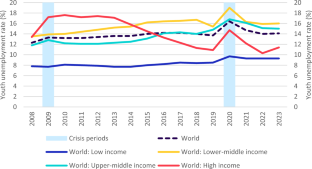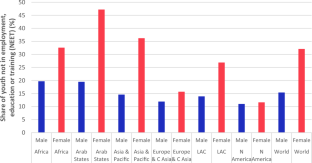The Challenge of Youth Employment: New Findings and Approaches

The challenge of youth employment is not new. Even in good economic times, young people experience unemployment rates that are 3–4 times higher than adults. More than three out of four of the world’s young workers have informal jobs, while young people are overrepresented in working poverty and less protected forms of work, such as temporary and gig employment. During economic crises, the situation for young people in the labour market deteriorates much faster than for adults and persists for longer periods. The scarring effects for youth were clear after the global financial crisis (GFC) of 2008–09. Beyond these negative trends, it is important to recognise where countries have done much better in getting young people into decent and productive employment, including in the wake of crises. The success of European countries in tackling youth unemployment and inactivity has led to many attempts to replicate the policy approach, which involves integrated programmes such as the EU Youth Guarantee. However, there are major constraints to applying such an approach in developing countries and emerging economies. Against this background, the paper reviews the longer run trends in youth employment, along with the impact of crises on young people, focusing on the COVID-19 pandemic, in both advanced and developing countries. Next, it explores the lessons learned on how best to deal with youth employment challenges drawing from recent global meta-analyses. While the paper highlights that not all lessons can be extrapolated, it is important that countries develop integrated youth employment strategies that address job creation, quality of jobs, and inclusion.
This is a preview of subscription content, log in via an institution to check access.
Access this article
Subscribe and save
Springer+ Basic
€32.70 /Month
- Get 10 units per month
- Download Article/Chapter or eBook
- 1 Unit = 1 Article or 1 Chapter
- Cancel anytime
Buy Now
Price includes VAT (France)
Instant access to the full article PDF.
Rent this article via DeepDyve







Similar content being viewed by others

Jobless and Stuck: Youth Unemployment and COVID-19 in India
Article 27 June 2023

Youth Labour Market Prospects and Recent Policy Developments
Chapter © 2018

Promoting Youth Employment in Europe: Evidence-Based Policy Lessons
Chapter © 2018
Notes
Resolution concerning statistics of work, employment and labour underutilization (ilo.org).
National data sourced from ilostat.ilo.org.
ILO modelled estimates, ilostat.ilo.org.
Source: Periodic Labour Force Survey, accessed from ilostat.ilo.org.
This takes into account population trends that are particularly important in developing countries (where the denominator changes more rapidly than in advance economies).
See ILO (2020) ILO Monitor: COVID‑19 and the World of Work – Second Edition, 7 April 2020 for more details on how the ILO classified at-risk sectors.
Federal Employment Agency, “Realisierte Kurzarbeit (hochgerechnet) Deutschland, Länder, Regionaldirektionen, Agenturen für Arbeit und Kreise (Monatszahlen)” database (accessed February 2023).
United States Bureau of Labor Statistics, “Unemployed Persons by Reason for Unemployment, Seasonally Adjusted”, Labor Force Statistics from the Current Population Survey. https://www.bls.gov/web/empsit/cpseea11.htm (accessed May 2021).
The reinforced Youth Guarantee—Employment, Social Affairs & Inclusion—European Commission (europa.eu).
References
- Barford, A., A. Coutts, and G. Sahai. 2022. Youth employment in times of COVID: A global review of COVID-19 policy responses to tackle (un)employment and disadvantage among young people. Geneva: ILO. Google Scholar
- Card, D., J. Kluve, and A. Weber. 2018. What works? A meta analysis of recent active labor market program evaluations. Journal of the European Economic Association 16 (3): 894–931. ArticleGoogle Scholar
- Eichhorst, W., P. Marx, U. Rinne, and J. Brunner. 2022. Job retention schemes during COVID-19: A review of policy responses. Geneva: ILO. Google Scholar
- Federal Ministry of Labour Austria. 2022. Jugend und Arbeit in Österreich - Berichtsjahr 2020/2021. Vienna
- ILO. 2017. Global employment trends for youth 2017. Geneva: ILO. Google Scholar
- ILO. 2022. ILO monitor on the world of work, 10th ed. Geneva: ILO. Google Scholar
- ILO. 2021. Briefing note: An update on the youth labour market impact of the COVID-19 crisis.
- Kahn, L.J. 2010. The long-term labor market consequences of graduating from college in a bad economy. Labour Economics 17 (2): 303–316. ArticleGoogle Scholar
- Kluve, J., S. Puerto, D. Robalino, J.M. Romero, F. Rother, J. Störeau, F. Weidenkaff, and M. Witte. 2018. Do youth employment programs improve labor market outcomes? A quantitative review. World Development 114 (237): 253. Google Scholar
- OECD. 2020. Job Retention schemes during the COVID-19 lockdown and beyond. Paris: OECD. Google Scholar
- Rinne, U., W. Eichhorst, P. Marx, and J. Brunner. 2022. Promoting youth employment during COVID-19: A review of policy responses. Geneva: ILO. Google Scholar
- Schwandt, H., and T. von Wachter. 2019. Unlucky cohorts: estimating the long-term effects of entering the labor market in a recession in large cross-sectional data sets. Journal of Labor Economics 37 (S1): S161–S198. ArticleGoogle Scholar
- Verick, S., D. Schmidt-Klau, and S. Lee. 2022. Is this time really different? How the impact of the COVID-19 crisis on labour markets contrasts with that of the global financial crisis of 2008–09. International Labour Review 161 (1): 125–148. ArticleGoogle Scholar
Funding
There is no funding for this article.









